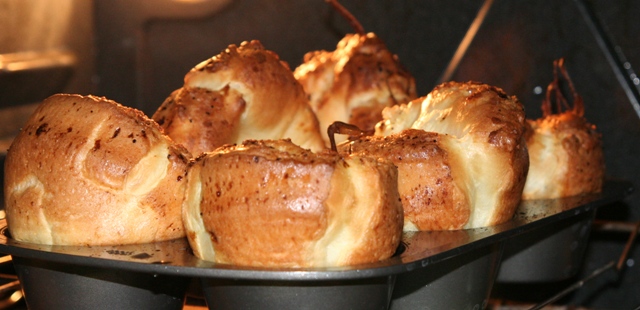Austrian Easter bread, farmer's recipe
It is that time of the year again, where I can't wait for the taste of sweet bread with smoked meats, hardboiled eggs and
freshly grated horseraddish. It is very traditional to eat this kind of bread for the Easter holidays, some even put raisins
in it and there is a much softer almost no crumb version out there. Oddly everyone seems to fancy the contrast of
meat/radish/horseradish on a very sweet bread, but only for the holidays. It is a tradition,what can I say. My mom
scored this recipe from a farmer and she called me very excited to try this. I thoght it was about time to not only soak in
so many wonderful reciped but share a somewhat special and different one. So this is the 2nd year I have a go at it,
I have gotten a bit tired of the neverending sourdough fermentation times and my inability to keep track of time.
This although is very different , it is a straightforward bread, you do not need a lot of time for it, and since it is so
enriched it does not benefit from long fermentation periods. I forgot how much fun it is to work with live yeast and
the sensational rise you get out of it, i doubt there can be a good sourdough version of this bread it is jsut perfect the way it is:
If former easterbread disappointed you because it was too soft, too little crust for you then you really
should try this it will reward you with a mouthwatering smell in your kitchen and a great aftertaste for your tastebuds
besides it is a LOT of fun to work with such a potent dough without all the wait usually included :)
Ingredients:
1000 g of bread flour
500ml of milk ( regular version, no skim milk )
130g of softened butter
1 lemon ( organic )
40g of live yeast
6 tablespoons of sugar
1 tablespoon of salt
lard ( from the pork )

I got very lucky these days finding the right kind of flour, more so because it is also very cheap it seems to have
an extreme tendency for perfect gluten development. Here bread flours are marked W700 this one is marked the
same way but milled a bit rougher than all the rest and binds very well. I recommend flour just like that.

To get started warm up the milk just a tad over handwarm, take a small bowl and dissolve first the sugar then
the live yeast in it. It is important to work with warm milk be careful to not get it too hot to kill off the yeast.
I followed a little discussion some time ago on sugar/yeast yes no.... All you need to do
is take 2 bowls add yeast into it once with sugar, once without and observe. I always add the sugar it helps
your bacteria much faster along the way :) Let me prove that point, i started halfway with the bowl,
5 min later....
If you do not have live yeast I believe the correct formula is 2/3 dry yeast and 1/3 instant yeast instead
of the ammount of live yeast:

Pour the yeast and rest of the milk into the center of the bowl add the softened butter and one skin of a zested big lemon
be generous when you grate your lemon , add the salt and knead by hand, it is a fun dough to do so, once the dough is
firm and it should be firm, add one scooped table spoon of pork lard it will make the dough very silky and tasty.
I do not recommend omitting the lard and lemon since these 2 ingredients are what make this bread so special....
In the meantime put your oven on 180 degree Fahrenheit. As I mentioned before this dough does not benefit from
long fermentation and that is exactly the fun part for a change. Cover the bowl with plastic wrap and let the dough rise at
least to double( better triple ) in size within an hour at room temperature, the dough should be warm from the warm
milk still and smell sweet/lemon like, an awesome smell :). Here is my dough not even after 40 min, it tripled:

Knead the dough down to original size, a technique I almost never see in American recipes but very common here, is to do
exactly that, a double rise. Since time is no issue we can help the process along with our oven at 180F( 80celsius). Once the
dough is kneaded down divide in 3 parts and generously slash an X on top. Since this dough is highly active, try getting some
surface tension onto it as described in Peter Reinhards BBA. I kind of failed here a bit as you can see later. I didnt have a
baking stone nor did I find the right rack as I baked at my friends house. I would definitly use a stone if i I had one there...
There is no need to prepare the oven for hearth baking whatsoever even for phase 2:

I had to wait maybe 10 minutes till this happened at only 180 . Guess I did not build up enough surface tension.


Once doubled in the oven slide out the rack and cover the breads with a 50% egg yolk 50% milk mixture, crank up
the oven to 370 degrees Fahrenheit / 180 degrees Celsius
and slide the bread right back in, no need to wait till it reaches that temperature. Wait until the bread is golden
brown and makes a hollow sound when tapped. I use hot air surround fan setting, if you do not have one
add 10 degrees.
Here is a shot of the final result, last year I had the height a bit better under control, you can also make the surface
more even when shaping, I did not bother it gives the bread a rustic look, and it is a farmer's recipe after all.


Here is a comparison shot the next day between an enriched sourdough I created ( curd cheese as enrichment/
pumkin seeds) You can see there definitly is a crumb and crust on this bread, much different than the storebought
ones that feel and taste like sweet Mc Donalds buns. This is one of the few breads that once taken out does not
benefit much from being toasted it will stay fresh quite a while and goes great with jam but also with the ingredients
I mentioned within the introduction. A special tip would be butter/hardboiled egg and some grounded horseraddish on top.
If you decide to make this bread I hope you enjoy this recipe as much as I did. Submitted to the YeastSpotting page
















